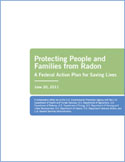Indoor Air Quality
Obama Administration Working to Close Racial, Ethnic Gap on Asthma: Asthma disproportionately affects minority children, children living below poverty level.
Please support us in communicating this plan to broaden engagement among federal agencies and non-federal partners and increase its reach and impact. The following resources are available to assist your communication efforts:
- Download the Action Plan one-page fact sheet (PDF) (2 pp., 288 K)
- Read the EPA News Release
- Get a Web button for your website.
Healthy Indoor Environment Protocols for Home Energy Upgrades

EPA has developed a new voluntary guidance document, Healthy Indoor Environment Protocols for Home Energy Upgrades, that provides a set of best practices for improving indoor air quality in conjunction with energy retrofit work in homes. Read more about the Protocols. Download the Protocols (PDF, 48 pp., 4.27 M, about PDF). Read the EPA Press Release.
The guidance was developed in collaboration with the White House Council on Environmental Quality (CEQ) Recovery Through Retrofit Initiative and the U.S. Department of Energy (DOE) initiative to develop Guidelines for Home Energy Professionals.
Federal partners release a Federal Radon Action Plan Scorecard
Get a glimpse of the current status of commitments made by federal agencies to reduce radon risk.
Learn more about this collaborative effort by federal agencies to protect people and families from radon.
Ten Things You Should Know About Mold
Here's the first 5, read 6 through 10.
- Potential health effects and symptoms associated with mold exposures include allergic reactions, asthma, and other respiratory complaints.
- There is no practical way to eliminate all mold and mold spores in the indoor environment; the way to control indoor mold growth is to control moisture.
- If mold is a problem in your home or school, you must clean up the mold and eliminate sources of moisture.
- Fix the source of the water problem or leak to prevent mold growth.
- Reduce indoor humidity (to 30-60%) to decrease mold growth by: venting bathrooms, dryers, and other moisture-generating sources to the outside; using air conditioners and de-humidifiers; increasing ventilation; and using exhaust fans whenever cooking, dishwashing, and cleaning.
| Basic Information Where You Live A to Z Subject Index | Frequent Questions Publications Science | Related Links Glossary of Terms Media/PSAs | ESPAÑOL Children's Health Cooperative Partners |
Top Questions/Tasks
How can I find ...?
- Publications and resources
- Information on resources near where I live
- An introduction to Indoor Air Quality
Asthma Advocate, Chris Draft, Former NFL Linebacker, launches National Public Service Announcement in partnership with the EPA. Watch the Video | Find out more about The Chris Draft Family Foundation
![]() .
.
Floods/Flooding
EPA's Natural Disasters and Weather Emergencies
Emergency Preparedness at http://www.ready.gov/







